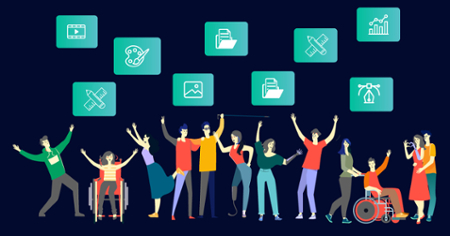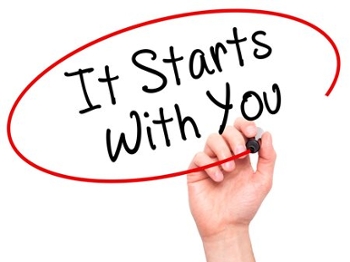Digital Accessibility Awareness
Overview 
What comes to mind when you think of the phrase digital accessibility? Maybe words like, user friendly, easy to access, intuitive, modern, universally designed, and streamlined.
Below are examples of digital accessibility barriers that can be challenging and time-consuming for most of us but absolutely unworkable and incredibly frustrating for those with disabilities.
- Have you ever clicked on a link that didn't navigate to where it was supposed to go? Or that it was entirely broken?
- Or, have you ever struggled to find what you were looking for on a web page because the information was disorganized or not located where one would expect it to be?
- Or, have you ever been in a crowded place like a bus, or forgot your headphones at the library, and not been able to understand a video because there weren't any captions?
The good news is that many if not all of the barriers we encounter on a daily basis can be resolved with some forethought and good design practices.
Why Digital Accessibility Matters
Barriers can affect the digital experience for all users and for this reason, accessible design benefits us all – not just people with disabilities. Additionally, invisible disabilities – a disability that cannot be identified from the outside – are also very common. Designing with accessibility in mind helps to dismantle the perception that one’s access to what they need depends on whether others perceive them as needing it or not. And, by creating an online experience accessible to all, you can also increase your audience.
Language Makes a Difference
Having the words to define your experience is crucial. It’s hard to look for solutions to your needs if you don't have the appropriate terminology.
It is important to remember that there are solutions in place already to remedy barriers, however they don't always have the recognition they require.
It's Just the Right Thing To Do
More than 2,900 UCSC undergraduates are affiliated with the Disability Resource Center (DRC). They receive accommodations and support for disabilities that include: physiological disabilities, like anxiety and depression; learning disabilities, like ADD and ADHD; and physical disabilities, like vision, hearing, or motor impairment.

It’s also important to recognize that it can be a lengthy, expensive process to undergo a formal assessment and possibly receive an official medical diagnosis. This means that the number of people with disabilities is likely underreported.
At a larger scale, the World Health Organization (WHO) reports that up to 1.3 billion people worldwide have a disability. It is clear that a significant portion of our campus community, and our global community, have disabilities that make digital accommodations and some proactive thinking about designing our digital experiences with accessibility in mind a necessity.

There are many disabilities that develop with age and affect abilities like fine motor skills, hearing, and eyesight. We can further distinguish between situational, temporary, and permanent disabilities. Accordingly, a person could find themselves in one of these three categories at any point and, depending on the disability, require different accommodations and benefit from an evolving array of assistive technologies that were previously unsuitable. The diagram of Microsoft's "Persona Spectrum" illustrates each of these categories.
Legal Impact
Doing the right thing means that we, as responsible individuals, are upholding our legal responsibilities.
There are also federal and state laws that require all of our electronic content, products and services (whether they be procured or developed internally) to be accessible. The pertinent federal laws include:
- The Americans with Disabilities Act (ADA)
- Section 504 of the Rehabilitation Act of 1973
- Section 508 of the Rehabilitation Act of 1973
The U.S. Department of Education's Office for Civil Rights (OCR) enforces federal civil rights laws that prohibit discrimination in education programs or activities that receive federal financial assistance. It should be noted that these laws protect:
- People with disabilities
- People with a history of having a disability
The UC systemwide Anti-Discrimination policy together with state and federal laws apply to all members of the University of California community. If we fail to comply, legal actions can result… and they can be quite expensive. Therefore, it saves both time and money to do things right proactively, instead of trying to work in accessibility at the last minute or as an afterthought.
What An Accessible Experience Looks Like
Here at UC Santa Cruz, there is a joint effort between departments to work towards improving digital accessibility on campus web pages and other electronic services. Some of the key changes:
- Updated procurement guide adopted at the University of California level to ensure all campuses are buying accessible software going forward
- Upcoming Canvas course to help instructors better incorporate digital accessibility into their courses
- Adding a new "Report a barrier" form to the universal footer on campus web pages to make it easier to report a barrier or request assistance.
Through these efforts, and continuing future initiatives, we hope to cultivate spaces that are inherently accessible, instead of creating situations where people have to ask for accommodations to navigate inaccessible spaces.
What You Can Do 
So, how can you be a part of the effort? There are many small things you can do that make a big difference for digital accessibility.
- Written content:
- Use accessible fonts that are easy to read
- Tip: Some of the most popular accessible fonts are Calibri, Arial, Roboto, and Times New Roman
- Aim for a font size of at least 12 pt
- Use accessible fonts that are easy to read
- Add alt text to pictures on social media, in emails, on webpages, etc.
- Tip: When posting on Instagram, click on “Advanced Settings” to add alt text to each picture in the post
- Make sure all text stands out against and contrasts with the background color
- Label links with what page they navigate to, instead of something like “click here” or just inserting the URL
- Add captions to your videos
- Tip: Videos on sites like YouTube and TikTok provide automatically generated captions but sometimes words can be incorrectly captioned so it’s still important to correct them when necessary
There is lots more being done here at UC Santa Cruz, and other UC campuses; the UC IT Blog post Accessibility Matters: Take 5 Actions outlines some of the actions UCSC is taking, and some things you can do as well. Together, we can work towards an effortless digital experience for everyone!

